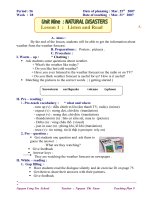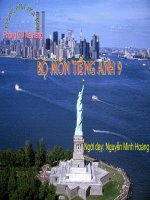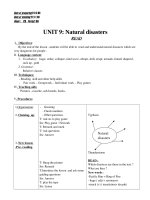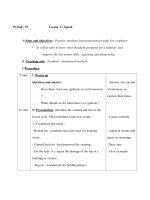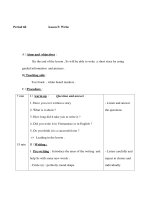Unit 9: Natural disasters
Bạn đang xem bản rút gọn của tài liệu. Xem và tải ngay bản đầy đủ của tài liệu tại đây (395.25 KB, 14 trang )
Date of planning : Mar. 25th 2007
Date of teaching : Mar. 31st 2007
Period : 56
Week : 28
A.
Lesson 1 : Listen and Read
A. Aims :
By the end of the lesson, students will be able to get the information about
weather from the weather forecast.
B. Preparations : Posters . pictures .
C. Procedure :
I. Warm – up :
* Chatting :
Ask students some questions about weather.
+ What's the weather like today?
+ Do you like hot/cold weather?
+ Have you ever listened to the weather forecast on the radio or on TV?
+ Do you think weather forecast is useful for us? How is it useful?
Matching the pictures to the correct words ; ( getting started )
Snowstorm
earthquake
volcano
typhoon
II. Pre – reading :
1. Pre-teach vocabulary :
* what and where
- turn up (v) : điều chỉnh to lên (âm thanh TV, radio). (mime)
- expect (v) : mong đợi, chờ đón (translation)
- expect (v) : mong đợi, chờ đón (translation)
- thunderstorm (n) : bão có sấm sét, mưa to (picture)
- Delta (n) : vùng châu thổ (visual)
- just in case (n) : phòng khi, lỡ khi (translation)
- trust (v) : tin tưởng, tin là thật (synonym: rely on)
2. Pre – question :
Get students one question and ask them to
guess the answer :
What are they watching?
Give feedback
Answer keys :
They are watching the weather forecast on newspaper .
II. While – reading :
1. Gap filling :
Have students read the dialogue silently and do exercise 2b on page 75.
Get them to share their answers with their partners.
Give feedback
*……………………………………………………………………………………………………….
*
Nguyen Cong Tru School
Teacher : Nguyen Thi Xuan
Teaching Plan 9
Answer keys :
a. Thuy's grandmother wants her to turn up the volume on TV
because she wants to listen to the weather forecast .
b. The coast of Thanh Hoa will be raining.
c. The central highlands will experience thunderstorms
d. Ho Chi Minh City will have temperature between 270C and 350C
e. Although Thuy's grandmother doesn't trust weather forecasts,
she likes watching them.
2. Comprehension questions :
* LUCKY NUMBER
Show the questions on the poster. Ask students to answer the questions
in pairs
Get students to call out their answers, teacher corrects if necessary
Answer keys:
a. Why does Thuy's grandmother ask her to turn up the volume?
- Because she wants to listen to the weather forecast
b. Which city is the hottest today?
- Ho Chi Minh City is the hottest.
c. Where is Thuy going?
- She’s going to a park on the other side of Thang Long
Bridge with her old friends (she's going on a picnic)
d. What does Thuy's grandmother want her to do?
- She wants her to bring along a raincoat .
1
d
2
c
3
LN
4
a
5
LN
6
b
Have students practice asking and answering in pairs .
3. Practice the dialogue :
Let students listen to the dialogue and focus on the pronunciation.
Call on some students to play the roles of Thuy, grandmother and
weatherman to practice the dialogue.
Ask students to practice the dialogue in groups of three .
III. Post – reading :
Speaking : Ask students to read again the weather forecast on TV and notice
some phrases.
*will have temperature between ...... and .......
* will experience temperature between ...... and .......
* HCMC. temperature will be between ... and ...
* can expect clouds/thunderstorms
Ask students to look at the map and play the role of the weatherman to
present the weather forecast, based on the information given.
Call on some students to present before the class.
Have students work in pair - one student speaks, the other listens.
*……………………………………………………………………………………………………….
*
Nguyen Cong Tru School
Teacher : Nguyen Thi Xuan
Teaching Plan 9
IV. At home : Ask students to write a weather forecast. The dialogue will help them.
Students can change the information, the places ...
Date of planning : Apr, 1st 2007
Date of teaching : Apr. 2nd 2007
Period : 57
Week : 29
Lesson 2 :
B.
Speak
A. Aims:
By the end of the lesson, students will be able to talk about what they want to buy and do to
prepare for a typhoon .
B. Preparations : Posters . pictures .
C. Procedure :
I. Warm – up :
* Brainstorming:
o Have students think about what they do to prepare for a typhoon
o Have students to go to the board and write down
Buy food
Preparation for a typhoon
Store water
o Possible answers :
o Check the doors and the windows.
+ Cut some branches of high trees in the garden or around the house .
+ Buy oil, gas
+Buy candles
+ Check the roof
II. Presentation :
1. Pre-teach vocabulary :
* Slap the board
- bucket (n) : cái xô (visual)
- leak (n) : chỗ thủng, chỗ dột (visual)
- tie (v) : cột, trói (mime)
- latch (n) : cái chốt cửa (picture)
- blanket (n) : cái mền (picture)
- available (adj) : có sẵn (translation)
- damage (v) : phá hỏng, làm thiệt hại (synonym of hurt or spoil)
2. Revision :
poster
Form :
Cái mền
MAY
+
INFINITIVE
MUST
Use : in deduction or prediction
Practice :
The water pipe may be damaged
There must be strong wind blowing
What happens if there is a typhoon?
Possible answers :
- There may be a power cut.
- There must be heavy rain.
- Big trees may fall down
- The market may be closed
*……………………………………………………………………………………………………….
*
Nguyen Cong Tru School
Teacher : Nguyen Thi Xuan
Teaching Plan 9
- There may be a flood.
- ...................
o Have students do exercise 3a on page 76. The students have to check (P) what
preparations they think should be done for a typhoon . ( Poster )
o Answer Key :
P Buying some canned food
Painting the house
Buying a dog
P Buying candles
P Buying matches
Hiring some video movies
P Filling all buckets with water
P Buying a ladder
Washing your blankets.
P Fixing the leak in the roof
P Tying the roof to the ground with pegs and ropes.
Inviting some friends over for a dinner
P Checking all the window and door latches
o Elicit some questions and get students to ask and answer .
o LUCKY NUMBER :
Poster
a. Why do we need to buy food ?
Because the market will be closed and no food will be available
b. What food do we need to buy ?
Rice, oil, canned food, soy sauce, flour...
c. Why do we need to buy candles ?
Because there may be power cut .
d. Why do we need to fill all buckets with water?
Because water pipes may be damaged and won’t have enough water to
use right after the typhoon .
e. Why do we need to buy a ladder?
Because the roof may be damaged by the typhoon, and we have to fix it .
f. Why do we need to check all the window and door latches?
Just in case the strong wind pushes the doors open .
1
2
3
4
5
6
7
8
LN
e
b
a
c
LN
f
d
o Ask students to use the expressions on page 77 when talking to one another .
+ I think ...
+ Yes, I think so .
+ I think you should ...
+ What for ?
...
III. Production : Poster
Groups of 4
o Have students talk about what they think they want to buy and do to prepare for a
typhoon ; explain why . They can use the questions and the answers above . Besides,
the ideas in the bubbles on page 77 can help students talk easily.
I think we should buy some canned food
before a typhoon
Yes , I think so, too / I agree with you . The
market
will be closed and no food will be available
I think we should buy a bladder
What for ? why ?
Just in case we need to fix the roof . Because there
*……………………………………………………………………………………………………….
must be strong wind blowing .
*
Nguyen Cong Tru School
Teacher : Nguyen Thi Xuan
Teaching Plan 9
o Go around and help students. Encourage students to show their own ideas
IV. Homework :
o Write something about what they have to do to prepare for a typhoon
Date of planning : Apr, 1st 2007
Date of teaching : Apr. 7th 2007
Period : 58
Week : 29
Lesson 3 :
Listen
A. Aims :
By the end of the lesson, students will get some ideas on how to live with earthquakes and
put suitable words or word phrases into the gaps to complete the table .
B. Preparations : Posters . pictures .
C. Procedure :
I. Warm – up :
* Chatting:
• Ask students some questions about earthquakes.
+ Have you ever head of an earthquake ?
+ What happens if there is an earthquake ?
+ In which country do earthquake occur frequently ?
+ What would you do if there was an earthquake ?
II. Pre-listening :
1. Pre teach vocabulary :
* What and Where
- block (v) : hạn chế, ngăn cản
(definition : make movement difficult or impossible
- roller (n) : trục lăn, con lăn (picture)
- strike - struck - struck (v) va chạm (synonym: hit)
- snout (n) : mõm của động vật ( visual/picture)
- hurricane (n) : cơn bão (in North and South America)
(synonym: typhoon in Asia)
- cyclone (n) : cơn lốc xoáy, bão (in Australia)
- eruption (n) : sự phun trào (núi lửa) (pictures)
Suggested phrases:
1. Make movement difficult or impossible (block)
2. Typhoon in North and South America (hurricane)
3. Typhoon in Australia (cyclone)
4. The synonym of "hit" (strike)
5. The nose or jaws of a animal (snout)
6. An outbreak or bursting forth (eruption)
2. Prediction : Poster
• Set the scene : An expert is giving a talk on how to live with earthquakes.
• Have students look at the box on page 77 and guess the works in the blanks from (1) to
(9)
• Give feedback
*……………………………………………………………………………………………………….
*
Nguyen Cong Tru School
Teacher : Nguyen Thi Xuan
Teaching Plan 9
C.
LIVING WITH EARTHQUAKES
Heavy fixtures , furniture , and appliances
Place heavy books on the _______(1) _________
Block the rollers on your _______(2)_____ and _____(3)____
Flying glass
Check ______(4)__________
Don’t put your bed near __________(5)___________
Earthquakes drill
Stay _______(6)___________
Sit _______(7)_______ or _________(8) ___________
Stand in the ________(9)__________
III. While - listening :
o Have students listen to the tape twice and check their prediction
o Answer key
(1) bottom shelf of the bookshelf
(2) fridge
(3) washing machine
(4) mirrors
(5) a window
(6) inside
(7) under a strong table
(8) doorway
(9) corner of a room
Tape transcript :
If you live in an earthquake zone, you should take some time to look around your house.
Place heavy books on the bottom shelf of your bookshelves. Block the rollers on your fridge
and washing machine to prevent them from moving. Put hanging potted plants in plastic
containers. Check the mirrors in your bathroom and bedroom. Make sure they can't move.
Don't put your bed next to window. Planning where you are going to be during an
earthquake is very important. The first thing to remember is to stay inside. Then you should
sit under a strong table or doorway, or stand in the corner of a room .
IV. Post – listening :
• T. asks Ss to retell what they should do to live with earthquakes, basing on these questions.:
- Where should we place heavy books?
- What should we do with our fridges and washing machines.
- Why should we check the mirrors.
- Where should we put our beds.
- Where should we stay/sit/stand during the earthquake?
• Quiz : 2 teams
-- Ask some questions
• Call out the questions and the students have to answer as quickly as possible. The team having
the right answer gets good marks. The team which has more marks wins the game
1. Which country won the 1998 Tiger Cup? (Singapore)
2. Which animal has 1 or 2 horns on its snout? (rhinoceros)
3. Which explorer discovered America? (Christopher Columbus)
4. Which planet is closest to the earth? (Venus)
5. Which animal was chosen to be the logo of Sea games 2003? (Buffalo )
6. Which ASEAN country is divided into two regions by the sea?(Malaysia)
7. Which food can you chew but can't swallow? (chewing gum)
8. Which thing can you swallow but can't chew? (water
V. Homework :
o Have students work in closed pairs to ask and answer the questions
*……………………………………………………………………………………………………….
*
Nguyen Cong Tru School
Teacher : Nguyen Thi Xuan
Teaching Plan 9
o Write a passage telling what we should do to live with earthquakes.
Date of planning : Apr, 4th 2007
Date of teaching : Apr. 9th 2007
Period : 59
Week : 30
Lesson 4 :
Read
A. Aims :
By the end of the lesson, students will be able to get more information about
the natural disasters in the world .
B. Preparations : Posters . pictures .
C. Procedure :
I. Warm – up :
* Matching and chatting
Show four pictures on the BB and ask students to match them with four
words: tornado , earthquake, volcano, typhoon.
1
2
3
4
Answer keys:
a. Tornado - picture 1
b. earthquake - picture 2
c. volcano - picture 3
d. typhoon - picture 4
Give students some questions about snowstorm/an earthquake/ a
volcano/ a typhoon?
+ Have you ever experienced any of these natural disasters ? What
happened ? How did you feel ?
II. Pre – reading :
1. Pre – teach vocabulary : R . O & R
- Tidal wave (n) : sóng thần (translation)
- abrupt (adj) : bất ngờ, đột ngột (synonym : quick, sudden)
- shift (n) : sự chuyển dịch, thay đổi (change of position)
- warn (v) : cảnh báo, báo trước (translation)
- funnel - shaped (adj) : có hình phểu (visual)
- suck up (v) : hút lên (translation)
- Tornado (n) : cơn lốc xoáy
2. True - False statements Predictions : Poster - groups of 4 - B. shut
o Set The Scene : There are 6 statements about the information of some
natural disasters. All of you have to read them and guess whether they
area true of false
*……………………………………………………………………………………………………….
*
Nguyen Cong Tru School
Teacher : Nguyen Thi Xuan
Teaching Plan 9
D.
o Get students to work in pairs to guess which statements are true and
which are false.
1. Most of the earthquakes in the world occur in the Ring of Fire .
2. The earthquake in Kobe in 1995 caused severe damage .
3. A huge tidal wave traveled from California to Alaska and hit
Anchorage in the 1960 s .
4. Typhoon, hurricane and tropical storm are different words for the
same natural disasters .
5. The eruption of Mount Pinatubo is the world's largest ever volcano
eruption .
6. A tornado looks like a funnel .
o Give feedback :
III. While – reading : B. opened
1. Feedback 2 :
o T. asks Ss to look at the book and check their prediction .
o Answer key : T T F T F T
2. Complete the sentences :
Poster
o Have students work in pairs and complete the sentences in exercise 5b on
page 79 .
o Answer keys :
1. The majority of earthquakes occur around the Pacific Rim .
2. During the earthquake in Kobe, many people were killed when homes,
office blocks and highways collapsed .
3. A tidal wave can only occur when there is an abrupt shift in the
underwater movement of the Earth .
4. In Australia, a tropical storm is known as a cyclone .
5. Christopher Columbus gave us the word "typhoon" .
6. A Tornado is a type of storm that passes overland below a
thunderstorm and sucks up anything that is in its path .
IV. Post – reading :
* Asking and answering
Groups of 4
Have students read the text again.
Group 1 asks a question , Group 2, 3, 4 answer it.
Group 2 asks another question , Group 1, 3, 4 answer
Go on until the four groups ask their questions.
Possible answers:
1. Why do people call the Pacific Rim "Ring of Fire".
- Because 90% of earthquakes occur around the Pacific Rim.
2. What will happen when there is an abrupt shift in the underwater
movement of the earth ?
- Tidal waves will happen .
3. What does "typhoon" mean ? - It means "big wind"
4. Can we predict a volcano?
- Yes. The scientists can warn us about the eruption .
V. At home :
*……………………………………………………………………………………………………….
*
Nguyen Cong Tru School
Teacher : Nguyen Thi Xuan
Teaching Plan 9
Have students write the exercise 5b into their notebooks, using their ideas .
*……………………………………………………………………………………………………….
*
Nguyen Cong Tru School
Teacher : Nguyen Thi Xuan
Teaching Plan 9
Date of planning : Apr, 4th 2007
Date of teaching : Apr. 15th 2007
Period : 60
Week : 30
Lesson 5 :
Write
A. Aims :
By the end of the lesson, students will be able to write a story
B. Preparations : Posters . pictures .
C. Procedure :
I. Warm – up :
* Jumbled words :
1. otnophy - typhoon
2. damotro - tornado
3. lacono - volcano
4. tearquahke - earthquake
5. ormost - storm
II. Pre – writing :
1. Pre-teach vocabulary : * what and where
- behave (v) : cư xử, ứng xử (translation)
- shelter (n) : chỗ trú ngụ (definition : a place of safety)
- all of sudden : bất ngờ, bỗng dưng (synonym: suddenly )
2. Telling the story ; Pictures
Show six pictures on the board .
Set the scene: This is Lan's family, they are at home.
Ask some questions to elicit the story.
Picture 1 :
- Who is this ? It's Lan
- Where is she ? She's outside / in the garden .
- What is she doing ? She's playing with her dog, Skippy.
Lan is outside playing with her dog .
. Picture 2 :
- How is the dog? It looks strange. Perhaps it is scared
All of a sudden, the dog behaves strangely.
Picture 3 :
- What's on TV? The weather forecast
- What does Lan's mother say? She tells Lan that she has just heard
on
*……………………………………………………………………………………………………….
*
Nguyen Cong Tru School
Teacher : Nguyen Thi Xuan
Teaching Plan 9
E.
- TV that there is a typhoon coming .
Lan ran home and her mother tells her that there is a typhoon
coming.
Picture 4 :
- What are they doing? They are gathering and talking about the
coming typhoon.
Mrs. Quyen gathers her family and asks them to find shelter
in the house .
Picture 5:
- What's the weather like now? It is very dark. It has strong wind and
heavy rain .
Suddenly, it becomes dark . The storm comes with strong
wind and heavy rain .
Picture 6 :
- What's the weather like now ? It's fine .
- How are they now? They all are happy.
The storm finishes soon and everyone is glad .
III. While – writing :
• Ask some students to look at the pictures and retell the story.
• Have students write a story individually. The cues in the box on page 79
will help students to write easily.
• Ask students to use past tense .
• Sample :
It was a beautiful day. The sun was shiny, the sky was blue and the
weather was perfect. Lan was outside playing with her dog, Skippy. All of
a sudden, the dog began behaving strangely. She kept running around
circles. Lan ran home with her dog to tell her mother what Skippy was
doing. Lan's mother, Mrs. Quyen told Lan that she heard on TV that there
was a typhoon coming. Mrs. Quyen gathered her family and told them to
find shelter in the house.
Suddenly, the sky became very dark. The storm came with strong wind
and heavy rain. Mrs. Quyen and her family were scared, but soon the storm
finished and everyone was glad. What a clever dog Skippy is . She saved Lan
from being caught in the typhoon.
IV. Post – writing :
- Take some writings to correct in front of the class .
- Ask students to rewrite their writings .
V. At home :
Collect their papers and correct
Get students to write another story. They can make changes or add more
details to the story.
*……………………………………………………………………………………………………….
*
Nguyen Cong Tru School
Teacher : Nguyen Thi Xuan
Teaching Plan 9
Date of planning : Apr, 4th 2006
Date of teaching : Apr. 13rd 2006
Period : 60
Week : 30
F.
Lesson 6 : Language Focus
A. Aims :
By the end of the lesson, students will be able to distinguish between defining
relative clauses and non - defining relative clauses.
B. Preparations : Posters . pictures .
C. Procedure :
I. Warm – up :
* Pelmanism :
Prepare 12 cards with numbers on one side and the words on the other.
Neil
Armstrong
Kangaroos
Japan
Tokyo
Australia The
USA
Lang
Son
Sacramento
Ky
Cung
California
Pompeii
Italy
II. Presentation :
1. Pre - teach vocabulary : * R. O & R
- sweep - swept - swept : quét, cuốn đi, tràn qua (mime)
- destroy (v) : phá huỷ (define : pull down or break to pieces)
- extensive (adj) : lớn, rộng lớn (synonym: wide, large)
- border (v) : tiếp giáp với (visual)
2. Revision :
Who is used for people .
Which is used for things .
That is used for people or things .
III. Practice :
Poster
1. Revision of who - which or that :
Ask them to answer the questions, using the Relative pronouns which or
who .
Give feedback - Correct their pronunciation .
• Answer keys :
a. The city which was struck by a huge earthquake in 1995 is Kobe.
*……………………………………………………………………………………………………….
*
Nguyen Cong Tru School
Teacher : Nguyen Thi Xuan
Teaching Plan 9
b. The country which won the 1998 Tiger Cup is Singapore
c. The animal which has one or two horns on its snout is rhinoceros.
d. The explorer who discovered America is C. Columbus.
e. The animal which was chosen to be the logo of SEA games 2003 is
buffalo.
g. The ASEAN country which is divided into two regions by the sea is
Malaysia.
h. The food which can you chew but you can't swallow is the chewing
gum and the thing you can swallow but you can't chew is water.
• Have Ss work in closed pairs to ask and answer the questions .
2. Defining and non-defining relative clauses:
Give Ss two pairs of sentences and ask them to use relative pronoun who
or which to combine them.
1. The novel has been lost. You gave me the novel on my birthday.
The novel which you gave me on my birthday has been lost.
2. Vietnam exports rice. Vietnam is in the Southeast Asia.
Vietnam, which is in the Southeast Asia, exports rice.
Help Ss distinguish between defining and non-defining relative clauses.
Defining relative clauses identify nouns. These clauses tell us which
person or thing the speaker means.
Non-defining relative clauses give more information about a person
or thing already identified. We put commas at the beginning and at the
end of the clause.( or a full stop at the end) .
NOTE: We cannot use “that” and cannot leave out “who” or “which”
in non-defining clause
Ask students to match each of the sentences in column A with a related
sentence in column B, then use a suitable relative pronoun to join them.
(exercise 2/ p. 81& 82) Poster
Get students to work individually, then share with their partners.
Answer key :
1 2 3 4 5 6 7
e g f a c d b
IV. Production :
* Writing
Poster
o Have students rewrite the sentences in exercise 2 on page 82.
o Ask students to replace each underlined clause with their own clause
o Let students use facts or their imagination.
a. Vietnam, which is a small country, exports rice
b. Kangaroos, which are called "Chuot tui" in Vietnamese, have long
tails.
c. Ba, who is my best friend, likes playing the guitar
d. (defining)
e. Neil Armstrong, who is a famous astronaut, lived in the USA.
f. (defining)
g. Miss. Lien, who teachers us English, is a beautiful woman.
*……………………………………………………………………………………………………….
*
Nguyen Cong Tru School
Teacher : Nguyen Thi Xuan
Teaching Plan 9
• Ask students to combine each pair of sentences into one. They have to
write in their notebooks
a. Do you know the people? They live in the White House.
b. The pill made me sleepy. I took it twice a day.
c. The magazine is very interesting. You gave it to me yesterday.
d. The building is the oldest in our city. It was built over 100 years ago.
V. At home : Have students write some more (about 5) sentences with non –
defining relative clauses.
*……………………………………………………………………………………………………….
*
Nguyen Cong Tru School
Teacher : Nguyen Thi Xuan
Teaching Plan 9
Period : 58
Week : 29
Date of planning : Apr, 1st 2008
Date of teaching : Apr. 7th 2008
*……………………………………………………………………………………………………….
*
Nguyen Cong Tru School
Teacher : Nguyen Thi Xuan
Teaching Plan 9
